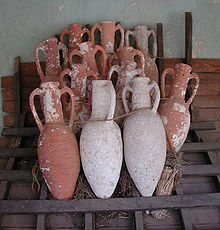- Dokos shipwreck
-
The Dokos shipwreck is the oldest known underwater shipwreck discovery known to archeologists.[1] The wreck has been dated to the second Proto-Helladic period, 2700-2200 BC.[2]
The remains of the shipwreck are located about 15-30 meters underwater off the coast of southern Greece near the island of Dokos (ancient name Aperopia) in the Aegean Sea.[3] Dokos island is about 60 miles east of Sparta, Peloponnese.[4]
The ship itself is long gone, as everything biodegradable has been taken back by the sea. The remains at the sea floor of a cargo site of hundreds of clay vases and other ceramic items are evidence of the shipwreck.[1] The four thousand year old ancient shipwreck was discovered by Peter Throckmorton on August 23, 1975.[5][6]
The Dokos wreck site was extensively excavated in 1989-1992 by the Hellenic Institute of Marine Archaeology (HIMA).[7] Archaeologist Dr. George Papathanasopoulos, President of HIMA, conducted this first ever full-scale excavation in Greece of an ancient shipwreck. Additional surveys were conducted and the Early Helladic period was confirmed.[8]
Contents
Evidence
According to HIMA, the Cycladic pottery evidence is dated to around 2200 BC and the oldest known underwater shipwreck yet discovered.[9] The clay pots appear to be merchandise from an ancient Argolida manufacturing facility.[4] It is guessed that these were intended for trade to small coastal villages around the Gulf of Argos and the Myrtoan Sea. The cargo site consists of one of the largest collections of Early Helladic II pottery known. This Helladic pottery technology was even before the invention of the pottery wheel.[8]
The pottery consisted of hundreds of ceramic pieces including cups, kitchenware, and urns. There were even seven different kinds of sauce boats. The bowls and sauce boats of the Early Helladic period were the commonest types found in southern and central Greece. There were many amphoras found, as well as basins, wide-mouthed jars, braziers, and baking trays. [10]
Stone anchors were also found. These were merely boulders with holes drilled through them.[4] There were also lead ingots used for trade found.[4] The merchant ship had a wide variety of tableware and it is speculated it traded all over the region.[11]
During the 1989 to 1992 HIMA excavation, the site produced more than 15,000 pottery sherds and artifacts. They also found many millstones at the site that is speculated was used as part of the ship's cargo or possibly as ballast. These artifacts and items were raised from the sea bottom and transported to the Spetses Museum. There they will be studied and placed into conservation.[10]
Notes
- ^ a b Anzovin, item 5396, p. 385: The oldest underwater shipwreck known to archeologists is the Dokos wreck, located in waters 60 to 85 feet (18 to 26 meters) deep in the Aegean Sea off the island of Dokos, Greece.
- ^ HomeboyMediaNews - "Attempt to purchase protected island of Dokos", April 17, 2007.
- ^ Hydra News: "Attempts to purchase protected island of Dokos", April 17, 2007.
- ^ a b c d Anastasi, pp. 1-2.
- ^ The Early Helladic Shipwreck (1992).
- ^ Destination Dokos
- ^ Dokos Shipwreck
- ^ a b Hellenic Institute of Marine Archaeology
- ^ Hellenic Institute of Marine Archaeology (HIMA)
- ^ a b The Dokos Cargo site
- ^ Engines of Our Ingenuity: A Minoan Wreck by John H. Lienhard
Sources
- Anastasi, P. "Aegean Sea Floor Yields Clues to Early Greek Traders." The New York Times, January 2, 1989.
- Anzovin, Steven et al. Famous First Facts (International Edition), H. W. Wilson Company, 2000, ISBN 08242-0958-3
Further reading
- A Brief History of Underwater Archaeology in Greece
- Hudson, Kenneth et al. The Book of Shipwrecks. Macmillan, 1979, ISBN 0333220927
Categories:- Archaeology of shipwrecks
- Ancient shipwrecks
- Shipwrecks in the Aegean Sea
Wikimedia Foundation. 2010.

